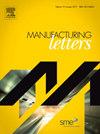3D melt blowing of Elastollan thermoplastic polyurethane for tissue engineering applications: A pilot study
IF 2
Q3 ENGINEERING, MANUFACTURING
引用次数: 0
Abstract
Scaffolds, in addition to being biocompatible, should possess structural and mechanical properties similar to the natural tissues they intend to replace. Many tissue engineering applications require porous 3D scaffolds characterized by unique microfibrous organization and mechanical anisotropy. Manufacturing process principles and process parameter-biomaterial interactions ultimately govern the properties that can be achieved in the scaffold. In this study, we investigate a recently developed nonwoven scaffold fabrication process, 3D melt blowing (3DMB), for processing Elastollan®, a thermoplastic polyurethane with basic mechanical properties suitable for musculoskeletal tissue engineering. The range of feasible processing parameters was screened and the effects of two sets of critical process parameters (fiber deposition offset and surface velocity of the collector) that produced contrasting scaffold morphologies were assessed. Results showed that scaffolds of Group B that were fabricated at the higher fiber deposition offset (90 %) and higher surface velocity of the collector (6 × 105 mm/min) possessed significantly smaller fiber diameter and higher porosity and degree of fiber alignment along the principal direction of collector rotation during 3DMB (all p < 0.05) compared to Group A scaffolds (fabricated at 50 % offset and 1 × 105 mm/min surface velocity). Although both groups possessed similar tensile stiffness, the elongation at failure was significantly different (p < 0.0001). The higher elongation at failure of Group B correlated with the higher degree of fiber alignment in these scaffolds. In contrast, the more isotropic fibrous organization of Group A contributed to their higher compressive stiffness (p = 0.004). The introduction of NaOH treatment to improve hydrophilicity of the scaffolds resulted in a significant reduction of tensile stiffness of Group A (p < 0.05) but not Group B. This treatment did not significantly affect the elongation at failure or compressive stiffness of both groups. With NaOH-treatment, both groups demonstrated good biocompatibility when seeded with fibroblast cells over 14 days. This study confirms the ability to fabricate via 3DMB, biocompatible, micro-fibrous, Elastollan scaffolds relevant for musculoskeletal tissue engineering.
用于组织工程应用的 Elastollan 热塑性聚氨酯三维熔体吹塑:试点研究
支架除了具有生物相容性外,还应该具有与要替代的天然组织相似的结构和机械特性。许多组织工程应用要求多孔三维支架具有独特的微纤维组织和机械各向异性。制造工艺原理以及工艺参数与生物材料之间的相互作用最终决定了支架所能达到的性能。在本研究中,我们研究了最近开发的一种无纺布支架制造工艺--三维熔体吹塑(3DMB),用于加工 Elastollan®,这是一种热塑性聚氨酯,具有适合肌肉骨骼组织工程的基本机械性能。对可行的加工参数范围进行了筛选,并评估了两组关键加工参数(纤维沉积偏移量和收集器表面速度)对产生截然不同的支架形态的影响。结果显示,与 A 组支架(以 50% 的偏移量和 1 × 105 mm/min 的表面速度制造)相比,以较高的纤维沉积偏移量(90%)和较高的收集器表面速度(6 × 105 mm/min)制造的 B 组支架具有明显较小的纤维直径、较高的孔隙率以及在 3DMB 期间沿收集器主要旋转方向的纤维排列程度(所有 p < 0.05)。虽然两组具有相似的拉伸刚度,但破坏时的伸长率却有显著差异(p < 0.0001)。B 组较高的破坏伸长率与这些支架中较高的纤维排列程度有关。相比之下,A 组的纤维组织各向同性更强,因此抗压刚度更高(p = 0.004)。为提高支架的亲水性而引入 NaOH 处理会显著降低 A 组的拉伸刚度(p < 0.05),但不会降低 B 组的拉伸刚度。经 NaOH 处理后,两组在 14 天内播种成纤维细胞时均表现出良好的生物相容性。这项研究证实了通过 3DMB 制造生物相容性微纤维 Elastollan 支架的能力,这种支架适用于肌肉骨骼组织工程。
本文章由计算机程序翻译,如有差异,请以英文原文为准。
求助全文
约1分钟内获得全文
求助全文
来源期刊

Manufacturing Letters
Engineering-Industrial and Manufacturing Engineering
CiteScore
4.20
自引率
5.10%
发文量
192
审稿时长
60 days
 求助内容:
求助内容: 应助结果提醒方式:
应助结果提醒方式:


